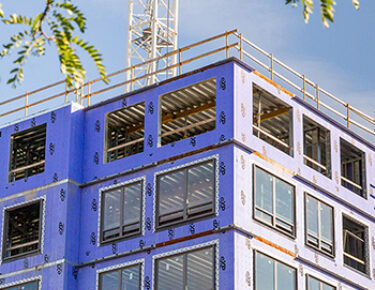 Building Knowledge
Building Knowledge
Designing wind-resistant structures: Sheathing and roof board considerations
eXP Sheathing and DEXcell Roof Board products help resist damage caused by wind loads on structures
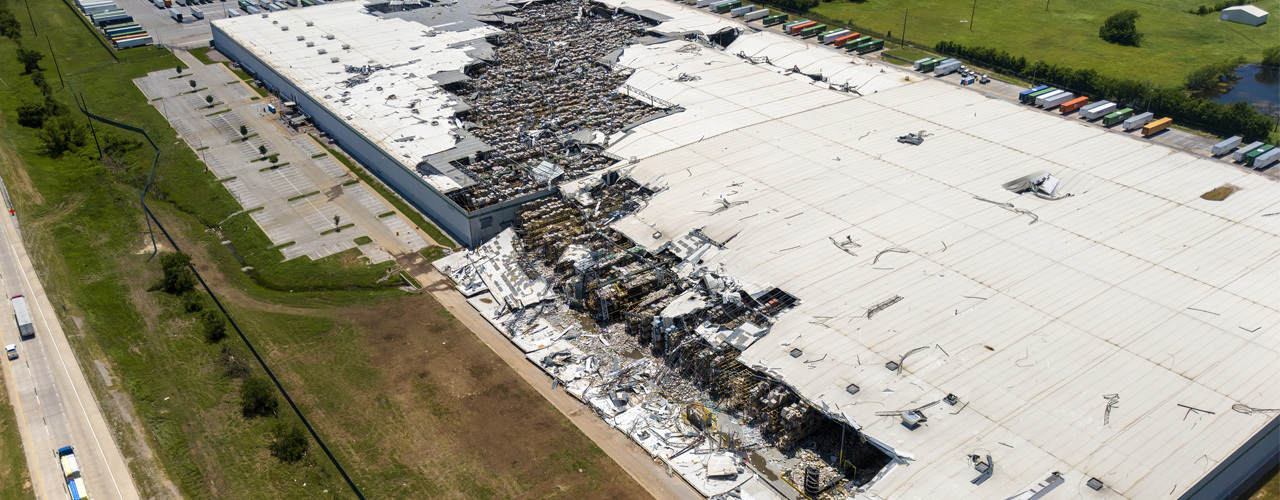
Wind is a powerful force that impacts building integrity daily, not just during hurricanes and severe storms. Building professionals must understand the dynamics of wind loads on a structure to design and construct resilient commercial buildings.
This article will explain the effect of wind forces on wall and roof assemblies and show how specific products manufactured by Gold Bond Building Products, LLC and PermaBASE Building Products, LLC — affiliates of National Gypsum Company — provide essential, high-performance gypsum solutions for wind resistance.
Understanding how wind forces affect walls and roofs
The fundamental challenge that wind presents to any building is the risk of components getting either blown or pulled off. This happens through a combination of forces that act on different parts of the building envelope simultaneously. Wind direction is dynamic and can switch throughout the day, meaning walls can experience both positive and negative pressure.
Wind load on walls
When wind strikes a building, it exerts different types of pressure on the walls, known collectively as wind load. These forces include:
- Positive pressure: Wind blowing directly against a wall, pushing inward.
- Negative pressure: Suction created as wind curls around the structure, pulling the opposite wall outward.
- Shear force: The pulling force that attempts to strip siding and other components off the wall as the wind moves around the sides of a building.
- Racking strength: An attempt, resulting from shear force, to collapse or damage the entire building as the wind moves around the sides of the structure.
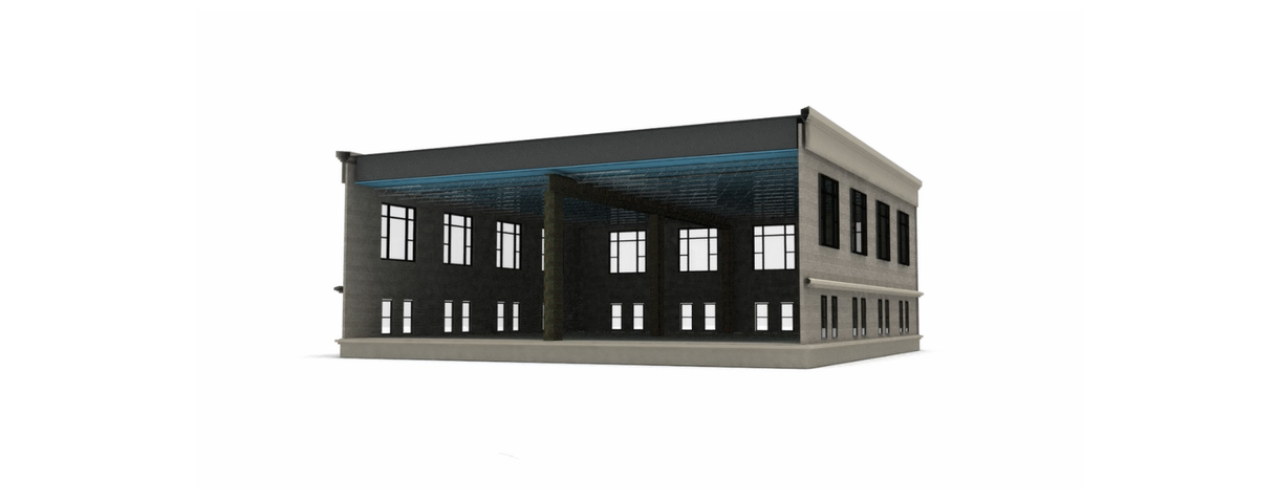
Wind uplift on roof systems
Wind uplift is the primary challenge for roof systems. This occurs when wind travels up a wall, over the parapet and across the roof surface, creating pressure that attempts to lift the roof and pull it off. This force creates significantly greater pressure on the roof perimeter and corners compared to the main field area.
The crucial role of wall sheathing: eXP Sheathing and wind resistance
Gold Bond® eXP® Sheathing provides a high-performance foundation in commercial construction with metal-framed steel studs. It serves as the substrate for various wall systems, creating a durable base for numerous claddings such as brick, stucco, metal panels or stone.
A strong bond against wind load
eXP Sheathing consists of a gypsum core — providing superior moisture- and mold-resistance — encased in a coated PURPLE® fiberglass facer. It’s the powerful bond between the fiberglass facer and the gypsum core that makes eXP Sheathing essential to resisting the negative pressure that pulls on the wall system.
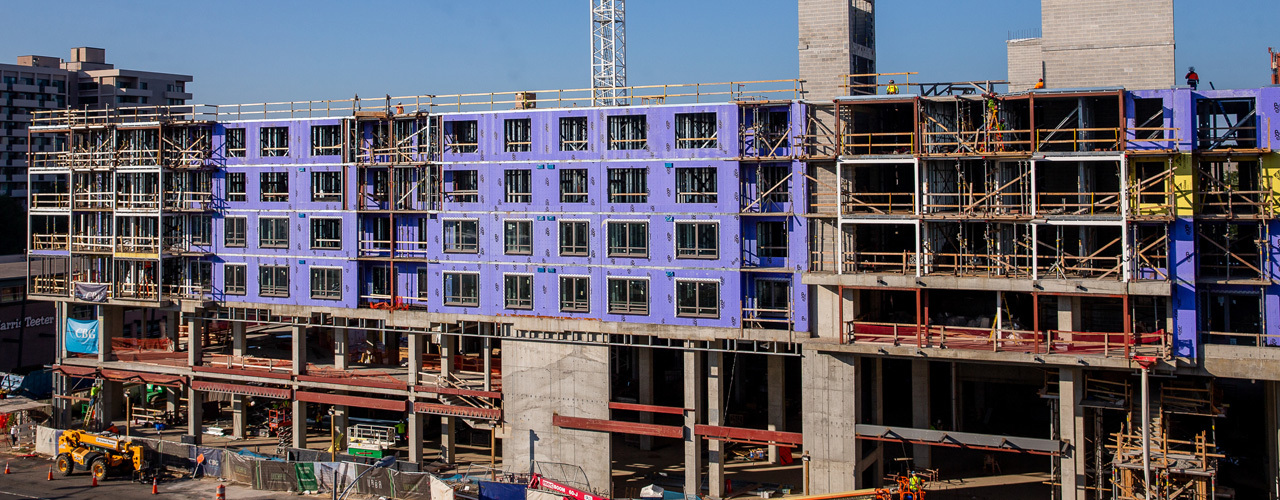
3 tips for strengthening the wall system beyond the sheathing
While the sheathing is a critical component, overall wall strength can be enhanced by:
- Framing spacing: Decreasing stud spacing from 24" to 16" or even 12" on center, especially in high-wind or seismic areas, enhances performance.
- Increased fasteners: Using more fasteners significantly improves the wall’s wind resistance.
- Vertical installation: Installing sheathing boards vertically rather than horizontally provides greater resistance to rack and shear forces.
Building wind-resistant roof assemblies: DEXcell Roof Board products and wind uplift
The International Building Code (IBC) adopted by the local jurisdiction dictates roof system design and construction. The IBC references the American Society of Civil Engineers 7, Minimum Design Loads for Buildings and Other Structures, to determine the design wind pressure for roof systems.
The IBC includes three testing options for roof assemblies:
- UL 580, Safety Testing for Uplift Resistance of Roof Assemblies
- UL 1897, Standard for Safety, Uplift Tests for Roof Covering Systems
- FM 4474, American National Standard for Evaluation of Simulated Wind Uplift Resistance of Roof Assemblies Using Static Positive and/or Negative Differential Pressures
Did you know? Factory Mutual is a commercial property insurance company that establishes design standards and testing protocols, known as FM Approvals, for building products and systems. For example, the DEXcell ® Roof Board family of products meets FM Class 1 fire rating, signifying that a building material or system has passed rigorous fire testing for limited flame spread and fuel contribution. While these standards are often required for FM-insured properties, architects often use “FM standard” and “code compliant” interchangeably in specification documents. FM Approvals is not a replacement for the local building code.
FM also maintains a database of FM-Approved roof systems in its RoofNav database.
Understanding roof systems testing protocols
Just as entire wall and floor assemblies carry fire and sound ratings, the design wind pressure rating applies to the entire roof assembly, including the membrane, fasteners, insulation, coverboard and roof-deck. The previously mentioned testing standards all evaluate wind uplift by placing a sealed assembly under a pressurized hood that simulates wind uplift by incrementally increasing pressure from below. However, each test has a slightly different scope.
- UL 580 subjects a 10' by 10' roof assembly to static and oscillating pressures to provide a baseline of wind resistance for a specific design pressure. This test stops before the assembly fails.
- UL 1897 takes UL 580 a step further by testing the assembly to the point of failure by increasing negative pressure in 15 pounds per square foot increments and holding at each level for 60 seconds.
- FM 4474 subjects the assembly (with an option for small or large format) to increasing static positive or negative pressure in increments of 15 pounds per square foot, holding for at least 60 seconds at each level until the assembly fails.
Tests that evaluate roof assemblies to the point of failure include a phase where the testing team deconstructs the assembly looking for the weakest link. The failure could be in the insulation, a fastener pulling out, the membrane peeling or the gypsum core of the board itself.
Assemblies tested in accordance with UL 1897 are assigned a class rating — for example, Class 90 or Class 105 — equal to the highest design wind pressure it held for 60 seconds. FM Approvals ratings are expressed in 15-minute increments,1-60, 1-75, 1-90. The first number represents a Class 1 fire rating based on a separate FM fire-resistance test, while the second number represents the design wind pressure, which is not equal to wind speed. Most designs are based on 1-90, the baseline pressure.
Designing roof assemblies for high-velocity wind zones
South Florida, the Gulf Coast and the Atlantic Seaboard are all subject to hurricane-force winds. Many jurisdictions in these areas have adopted building codes with a high-velocity wind zone (HVWZ) designation, which requires more robust designs for roofs.
Additional reinforcement for commercial roof assemblies in HVWZ areas includes high-strength fasteners and adhesives, but adding a layer of coverboards, such as DEXcell Roof Board products, can help the roof assembly withstand greater wind uplift forces.
DEXcell Roof Board products are engineered to counter wind uplift forces
- Strength of the back mat: Unlike wall sheathing where the face is critical, the most important bond for a roof board is the adhesion of the back mat to the gypsum core because wind uplift attempts to pull the board away from the roof-deck.
- Load distribution: The inherent rigidity and mass of a hard coverboard such as DEXcell helps to distribute the wind load across the roof system, absorbing uplift pressure more effectively.
- Correct installation: The boards are clearly labeled with “this side up” on the back of the board to ensure they are correctly installed.
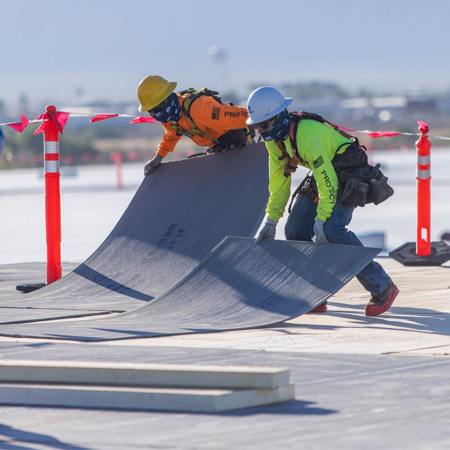
DEXcell roof coverboards can be used in a variety of environmental conditions and roof assemblies
- DEXcell® Cement Roof Board is a lightweight option ideal for high-moisture areas to provide support for the roof membrane.
- DEXcell® Glass Mat Roof Board is recommended for mechanically attached single-ply membranes, metal and fire/thermal barrier applications.
- DEXcell FA® Glass Mat Roof Board is recommended for fully adhered single-ply membranes, cold-applied modified bitumen, fluid-applied and metal systems.
- DEXcell FA VSH® Glass Mat Roof Board is approved for use in single-ply and multi-ply assemblies meeting FM Very Severe Hail classification.
Structures where performance matters most
High-performance building products such as DEXcell roof boards and eXP Sheathing are vital to resisting wind loads on structures to protect the people and property inside and the owner’s investment. Key building types include:
- Data centers
- Distribution centers
- Government buildings
- Hospitals
- Offices
- Schools
Fiberglass mat gypsum products are a key component in resilient building envelope assemblies
Modern building codes demand high-performance wall and roof systems to withstand increasingly stringent code requirements and growing threats from extreme weather. eXP Sheathing provides a robust foundation for walls to counter wind load, while DEXcell Roof Board products offer superior wind uplift resistance for roofs. By choosing high-performance gypsum products, architects and contractors can ensure their buildings protect both investments and lives.
Contact 1-800-NATIONAL® Construction Services to get technical advice for your next build.
Be the first to hear of new NGConnects blog posts by subscribing here for early access.





